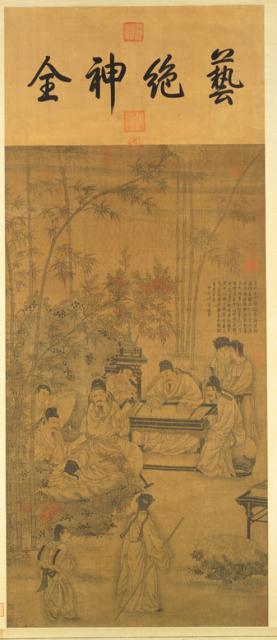唐閻立本竹林五君圖 軸
推薦分享
資源連結
連結到原始資料 (您即將開啟新視窗離開本站)後設資料
- 資料識別:
- 故畫000002N000000000
- 資料類型:
- 類型:繪畫
- 型式:靜態圖像
- 著作者:
- 閻立本
- 主題與關鍵字:
- 高士(士人、隱士) 竹 奇石 侍從(侍女、童僕) 傢俱(屏風) 飲食器 文房用具 文玩(琴棋書畫)
- 出版者:
- 數位化執行單位:國立故宮博物院
- 格式:
- 本幅 137.2x74.3公分、詩塘 39.8x74.5公分
- 關聯:
- 故宮書畫錄(卷五),第三冊,頁1&*石渠寶笈續編(寧壽宮),第五冊,頁2620&*故宮書畫圖錄,第一冊,頁5-6&*閻立本(約西元七世紀),榆林盛樂(今綏遠和林格爾)人。他和他的父親閻毗,哥哥閻立德都擅長於繪畫。曾奉令描繪各邦蠻夷、職責、鹵簿、秦府十八學生、凌煙閣功臣等圖像。 畫中有清高宗題討,高宗認為這幅畫是描繪「晉竹林七賢」稽康、阮籍、山濤、向秀、劉伶、阮咸、王戎,其中王戎與山濤沒有畫入圖中。左下角的竹桿上有「閻立本畫」的款字,當為後人假托之作。 &*Yen Li-pen was a native of Yü-lin, Sui-yüan. During the reign of T'ai-tsung (627-649), he was summoned to paint various subjects, such as tribute bearers, barbarians and scholars. He also painted the portaits of the Eighteen Scholars and the Meritorious Officials in the Ling-yen Hall. He acted as a high minister to Emperor Kao-tsung (650-684). The seven scholars Chi K'ang, Juan Chi, Shan T'ao, Hsiang Hsiu, Liu Ling, Juan Hsien and Wang Hung often met in a bamboo grove and later became known as "The Seven Sages of the Bamboo Grove." Although only five gentlemen appear in this work, the Ch’ing Emperor Ch'ien-lung (1736-1796) believed that it depicted the Seven Sages with Wang Hung and Shan T'an missing‐‐thus the modified title. On the bamboo stalk on the lower left corner appears the inscription, "Painted by Yen Li-pen," which is a later interpolation.
- 管理權:
- 國立故宮博物院
授權聯絡窗口
- 國立故宮博物院圖像授權、出版授權、影音資料授權-申請流程說明
http://www.npm.gov.tw/zh-TW/Article.aspx?sNo=03003061






